#Yamas & Niyamas
Explore tagged Tumblr posts
Text
A Short Introduction to the Yoga Sutras
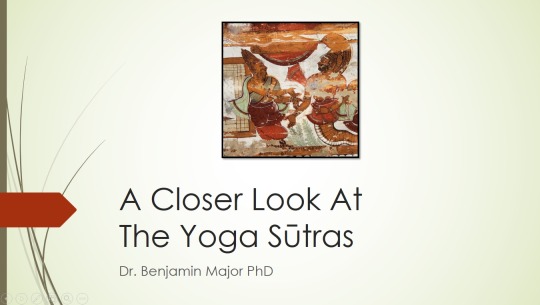
The Yoga Sutras are generally considered a foundational text of the yoga tradition. In this article we examine the context and background of the text, briefly explore its structure and content, and I also offer some reflections on the text’s relevance in modern times.
Note: I have decided not to use diacritics in this article. Diacritics are those little lines and dots above and below letters that tell you how to pronounce Sanskrit words. Normally I use diacritics in my writing, as they are essential for pronouncing Sanskrit correctly. However as this article is meant for non-scholars I have decided it would be better to try and write the Sanskrit words in a way that will make them easy to read and pronounce, so as not to put anybody off!
History & Context
Most scholars these days date the Yoga Sutras to somewhere between the 2nd and 5th centuries CE, with Philipp Maas placing it in the early 5th century.
The text is attributed to a sage named Patanjali. Biographically, we know next to nothing about Patanjali. The name is a compound word formed from the Sanskrit words pata (falling, flying) and anjali (the gesture of joining the hands together in reverence).
Yoga had already been around in some form or another for many centuries by this point. Therefore, Patanjali did not ‘invent’ Yoga. Nevertheless, this is the earliest comprehensive and systematic text on the subject that has survived.
Yoga was just one darshana or school out of many in ancient India. In terms of philosophy, it shares many similarities with the Samkhya school. But whereas Samkhya tends to emphasise the use of reason and knowledge to gain liberation, Yoga emphasises practical and experiential methods.
Philosophically, both the Samkhya and Yoga schools teach a form of dualism. This is a dualism between purusha (our true Self) and prakriti (everything else, including the body and mind) and the whole point of Samkhya and Yoga in a nutshell is to guide us towards the realisation of purusha, that is, our true Self. This is true liberation or moksha in Yoga.
Most of the ancient darshanas had their own sutra text. Sutra texts are known for their brevity. Basically, sutra texts are where the most essential teachings of a school are distilled into as few words as possible. Knowledge systems were handed down orally in ancient India and thus source material was kept minimal with a view to facilitating memorisation.
Other authors would then come along and write longer commentaries on these sutra texts. The Yoga Sutras have a rich commentarial tradition spanning many centuries. The first and most well known is the bhasya commentary by a certain Vyasa. Vyasa actually means something like ‘compiler’ or ‘editor’ so that probably wasn’t his actual name!
Some scholars even argue that Patanjali and Vyasa are actually one and the same person, though others would strongly disagree with this thesis. Either way, this commentary is indispensable when it comes to making sense of the sutras, and published versions of the Yoga Sutras tend to include the bhasya commentary or at least reference it.
As a final note, many scholars now use the term pātañjalayogaśāstra to refer to this text as a whole (sutras plus commentary), because that is the name our oldest existing manuscripts use. But to keep things simple we will continue to use the name Yoga Sutras!
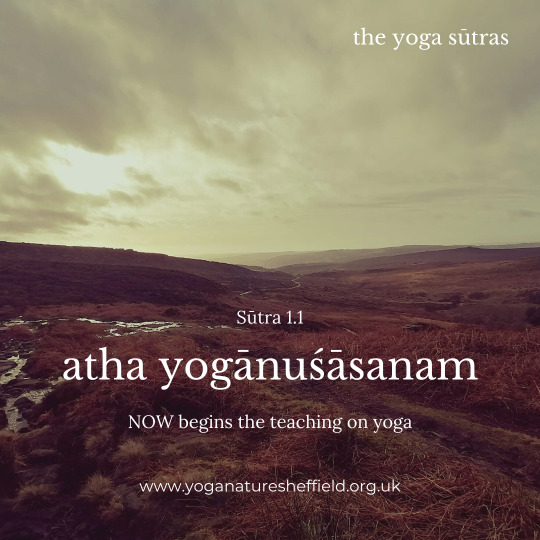
Structure of the Text
The Yoga Sutras are divided into the following four padas or chapters:
Samadhi Pada: This is where Patanjali defines Yoga and then describes the nature and the means to samadhi, the goal of Yoga.
Sadhana Pada: Sadhana is the Sanskrit word for practice or discipline. Here the author outlines two forms of Yoga, the kriya yoga (yoga of action) and the ashtanga yoga (the yoga of eight auxiliaries or limbs). This is also where Patanjali discusses the kleshas, five ‘afflictions’ or impediments to Yoga.
Vibhuti Pada: Vibhuti is the Sanskrit word for power or manifestation. Supra-normal powers (siddhis) are said to be acquired by the practice of Yoga. However, the temptation of these powers should be avoided and the attention should ultimately be fixed only on liberation.
Kaivalya Pada: Kaivalya literally means isolation. This is the chapter on final liberation. The Kaivalya Pada describes the process of liberation, it explains how the mind is constructed and veils the inner light of the Self.
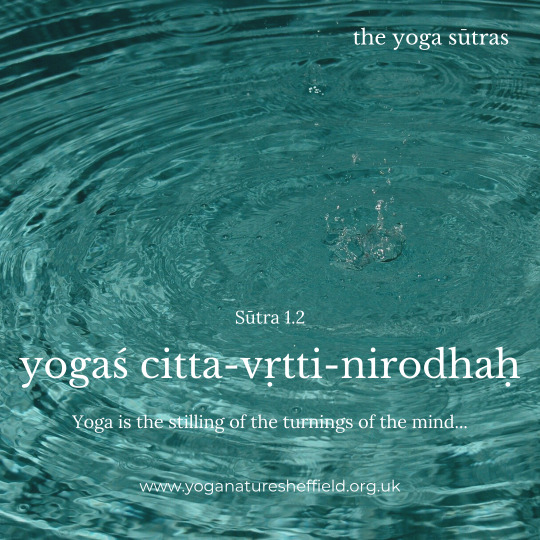
The Goal of Yoga
Not one for a lengthy preamble, Patanjali gets stuck right in there and clearly states the goal of Yoga in the well-known second sutra:
yogas chitta-vritti-nirodhah YS 1.2
Any Sanskrit sentence allows for a number of possible translations and this one is no different. A nice and accurate one is this one from Barbara Stoler Miller:
Yoga is the cessation of the turnings of thought
The reason I say this one is accurate is because a literal meaning of vritti is ‘turning’. Ever felt that thoughts are ‘going round and round’ in your head? Well this phrase nicely captures that! The vrittis in this statement refer to thoughts, emotions, ideas and basically any cognitive act of the mind. Patanjali lists five types of vrittis. These are, once translated:
Right knowledge
Error or false knowledge
Imagination
Sleep &
Memory
All such activities of the mind are products of prakriti and are completely distinct from the true Self, purusha, that pure awareness or consciousness which we are aiming to enter into through Yoga. The means prescribed by Patanjali in the first chapter of the Yoga Sutras to still the vritti states of mind are sustained practice (abhyasa) and dispassion (vairagya).
Specifically the practice offered is meditation, or keeping the mind fixed on any particular object of choice without distraction. Patanjali then describes a number of possible forms such meditation could take. By stilling all thought, meditation removes all objects of awareness. Awareness can therefore now be aware only of itself, of its own source, the true Self or purusha. This state is known as samadhi in Yoga and Patanjali makes it super clear that this state of samadhi is the goal of Yoga and thus the whole text is focused upon achievement of that goal.
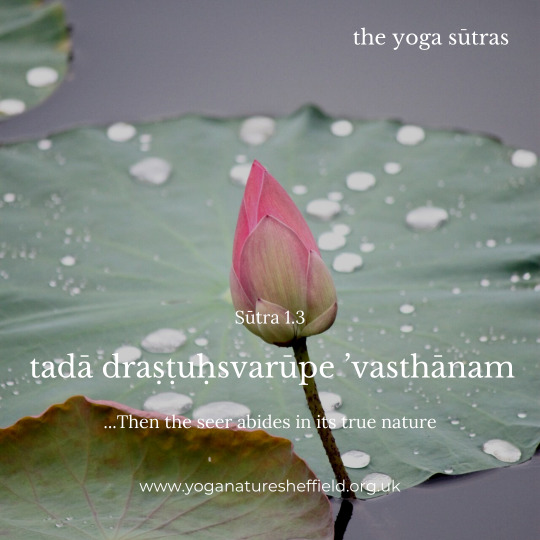
Obstacles to Yoga
Patanjali mentions five kleshas, which can be translated as impediments or obstacles to achieving samadhi and thus Yoga. These five are as follows:
Ignorance
Ego
Desire
Aversion
Clinging
In the Yoga Sutras, and indeed in ancient Indian philosophy in general, the first item in any list is the most important and fundamental. It’s the same here. Ignorance here means failing to recognise our true Self or purusha and instead identifying ourselves with our body, mind and the material world. All of the other obstacles arise from this fundamental error.
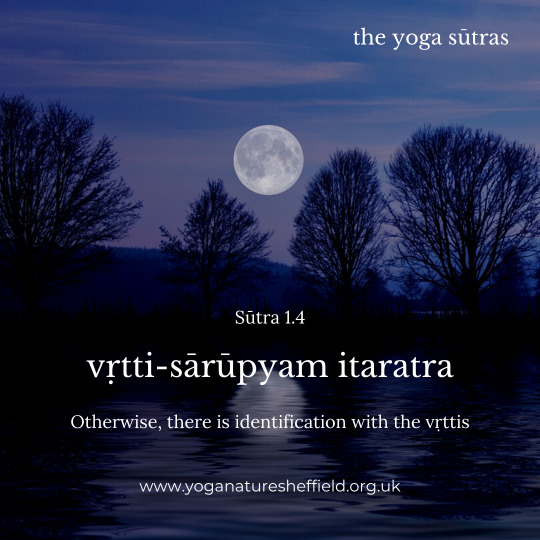
Yoga Psychology
Like most other schools of Indian thought, the Yoga school believed in the related concepts of karma and rebirth. According to this doctrine, we are caught in an endless cycle of rebirths called samsara and the purpose of following a path such as Jainism, Buddhism or Yoga is to bring an end to this cycle. Where the Yoga Sutras really shine are in interpreting this doctrine in a highly sophisticated ‘psychological’ way, to use modern terminology.
According to this Yoga psychology, the mind forms an impression of an object through the sense organs, which is called a pratyaya. Once this pratyaya or active image of this object is no longer of active interest to the mind, it becomes an inactive or latent samskara. A samskara is an imprint left in the chitta, somewhat like a sound is imprinted on a tape recorder, or an image on photographic film. In this way the vrittis, the activities of the mind, are retained as samskaras when they fade.
It is important to note that these samskaras are not just passive imprints but vibrant latent impulses that can get activated under conducive circumstances and can exert influence on a person’s thoughts and behaviours, even many years after the impression was made. What’s more, according to Yoga these samskaras can persist from previous lives. The chitta is thus something of a storehouse of these recorded samskaras, deposited and accumulated there over countless lifetimes. One is here reminded of the theory of the subconscious in modern psychoanalysis.
According to Yoga, karma is generated by the vrittis, and the vrittis, in turn, are produced by the kleshas. There is thus a vicious cycle of kleshas, vrittis and samskaras. To run through the whole cycle again to try and make it as clear as possible: vrittis are recorded in the chitta as samskaras, and these samskaras eventually activate consciously or subliminally, producing further vrittis. These vrittis then provoke actions and reactions, which in turn are recorded as samskaras, and the cycle continues endlessly, leading to much suffering along the way.
The whole Yoga project aims to bring this vicious cycle to an end and it is liberation from this mind created suffering that we are after as yogis. The Yoga Sutras are effectively a manual guiding us towards this end, this state of samadhi or complete meditative consciousness.

The Yamas and Niyamas
The second pada or chapter of the Yoga Sutras contains a famous exposition of five ethical restraints (yamas) and five ethical observances (niyamas) and these are relatively well-known in the modern yoga world. The first thing to get clear is that these yamas and niyamas are NOT original or unique to Yoga. All ascetic schools in ancient India had these ethical codes, and the exact same ones appear in Jainism for example. Sometimes, you even get more of them. Some yoga texts for instance list 10 yamas and 10 niyamas.
The five yamas listed in the Yoga Sutras are:
Ahimsa (non-harming) Satya (truth telling) Asteya (non-stealing) Brahmacharya (chastity or celibacy) Aparigraha (non-acquisitiveness)
The five niyamas are:
Shauca (purity or cleanliness) Santosha (contentment) Tapas (self-discipline) Svadhyaya (study) Ishvarapranidhana (devotion to the Ishvara or Lord)
Many of these could do with further explanation and commentary but there is not space in this present article. The other thing I want to stress is that these yamas and niyamas were not seen as optional extras for yogis. Rather, these were the bedrock of fruitful yoga practice. Patanjali and others refer to them as the mahavratam or ‘great vow’. Importantly, having listed the yamas, Patanjali devotes an entire sutra to reiterating just how central and non-negotiable these yamas are. Once translated, this sutra reads as follows:
[These yamas] are considered the great vow. They are not exempted by one’s class, place, time or circumstance. They are universal. YS 2.31
So, regardless of your social status, regardless of where you live, in which time period you live, and any other extenuating circumstances (such as your career), adherence to the yamas, including especially ahimsa, the foundation of them all, is an essential part of being a yogi as defined by Patanjali’s system.
Vyasa is even more emphatic in his bhasya commentary to the Yoga Sutras, and it is here that the link between ahimsa and vegetarianism is explicitly and unequivocally made, and several examples are brought to bear. Refer to the work of scholar Jonathan Dickstein to read more about the strong case for vegetarianism made in Patanjali Yoga.

The Ashtanga Yoga
These yamas and niyamas are just the first two parts of Patanjali’s famous ashtanga or eight-part path. I would first like to clarify that this systematisation of yoga into a series of angas (a word translated by some modern scholars as ‘auxiliaries’ but more commonly rendered as ‘limbs’) was again not novel to Patanjali. Throughout the yoga tradition we find various similar schemes, predating and postdating Patanjali, including fourfold, fivefold, sevenfold and even fifteenfold schemes. I would also like to stress that, despite sharing the same name, this ashtanga yoga bears little relation to the modern postural form of yoga known as Ashtanga.
Following the yamas and niyamas then, we then have the following six angas:
Asana (posture): At last I hear you cry, postures! In Patanjali’s day meaning a steady and comfortable seated posture, asanas today comprise a set of physical exercises which stretch and strengthen the body. It is this aspect of yoga that has been most visibly exported to the West but too often stripped from its context as just one ingredient in a more ambitious and far-reaching sequence.
Pranayama (breath control): Prana refers to the universal life force whilst ayama means to regulate or control, but it can also mean to expand and lengthen. Prana is the vital energy needed by our physical and subtle layers, without which the body would perish. It is what keeps us alive. Pranayama is thus the control or expansion of prana through the breath, depending on which definition of ayama you use.
Pratyahara (withdrawal of the senses): This limb further deepens the above process by removing consciousness from all engagement with the senses (sight, sound, taste, smell and touch) and sense objects.
This is followed by the final three limbs collectively known as samyama: Dharana (concentration, fixation), Dhyana (meditation), and finally Samadhi (the latter of which Patanjali further divides into seven rather esoteric stages). These last three limbs are essentially different degrees of concentrative intensity and culminate in the realisation by the Self of its own nature.
Just to reiterate one more time, it is this Self-realisation, the state known as samadhi, that is the true goal of Yoga.

Relevance of the Yoga Sutras for Today
In this brief introduction we have of course only scratched the surface of this incredible text, and there is much more that could be said. But for now I want to end with some concluding reflections on the continuing relevance of the Yoga Sutras in the modern world.
One question that arises is whether Patanjali was prescribing a strictly ascetic path. And indeed, the general scholarly consensus has usually been to associate Patanjali's Yoga exclusively with extreme asceticism, mortification, denial and renunciation. However, there are dissenting vocies. For example, Ian Whicher has repeatedly and passionately argued that Patanjali's Yoga can be seen as enabling a more responsible living in and engagement with the world, and that Patanjali was not advocating total renunciation. For Whicher, following the path of Patanjali can lead one towards that integrated and embodied state of liberated selfhood whilst living, a state known as jivanmukti.
Regardless of whether Patanjali was historically preaching ascetism or not, the fact remains that the Yoga Sutras are full of valuable ideals and tools for the practitioner living in the modern world. Let’s face it though, this is a challenging path. As a scholar and practitioner I often perceive a huge disconnect between the kind of yoga I am seeing on the likes of Instagram and the teachings of the Yoga school as presented in the Yoga Sutras. After, all, the former is highly focused on body image, whereas the Yoga of Patanjali is all about dissociating ourselves from our body and mind and recognising our true Self. However, this does not mean that the two are necessarily irreconcilable.
Though there is absolutely no historical evidence that Patanjali and his followers were practicing postural yoga (that didn’t come until later with the emergence of the Hatha tradition) nowhere in the Yoga Sutras does it say that physical exercise cannot be part of one’s yoga practice. We just have to remember that as far as Patanjalian Yoga is concerned, such postural activity is just a further means or method on the path towards samadhi or full meditative awareness. This is why any so-called yoga that does not contain more internalised meditational practices but which focuses solely on physical exercise should not really be called yoga.
The Yoga Sutras remains undoubtedly the most famous ancient yoga text, and it is studied to some extent in probably every yoga teacher training course. To be honest, I personally feel that too much emphasis is placed on the Yoga Sutras, at the expense of other branches and other texts of the tradition. The Tantric texts, in particular, are still sorely neglected. One of my own aims in my work is to try and decentre the Yoga Sutras and provide a much wider overview of the history and philosophy of yoga and the other related schools of ancient India. This is not to take anything away from the Yoga Sutras, however, as it is without doubt an extraordinary text that continues to be highly relevant in the 21st century.
Further Reading
I have already mentioned some scholars whose work you may wish to refer to, such as Philipp André Maas, Ian Whicher and Barbara Stoler Miller. For a translation and commentary on the Yoga Sutras that is both scholarly accurate and reasonably accessible I would recommend that of Edwin Bryant published by North Point Press.
11 notes
·
View notes
Text
The Journey of Practicing Kindness Toward Ourselves
In an effort to stay more connected to myself and the universe, and to keep striving toward some kind of enlightenment, I've recently been diving into the practice of yoga. And honestly, I’ve been so ignorant about what yoga really is for a while now. I used to work with some yogis and, like a lot of people, I assumed it was all about the poses (aka asanas) and cool stretches. But turns out, that’s only a small piece of the overall practice of yoga.
What I’ve come to learn is that yoga is rooted in an entire philosophy called Ashtanga Yoga, and it’s got so much depth. Ashtanga Yoga is actually made up of 8 limbs (or branches), each offering different ways to live more mindfully and harmoniously. Here’s a quick rundown of the 8 limbs:
Yamas (moral restraints)
Niyamas (personal observances)
Asanas (postures, the physical poses we often associate with yoga)
Pranayama (breath control)
Pratyahara (withdrawal of the senses)
Dharana (concentration)
Dhyana (meditation)
Samadhi (a state of unity or enlightenment)
Pretty cool, right? So, it all starts with the Yamas, which are basically guidelines on how to live ethically in relation to others and the world around us. There are five yamas, and they’re like the foundation of a peaceful and intentional life.
The first yama is Ahimsa, which means non-violence or non-harming. This one really caught my attention, especially as I’m learning more about it. Ahimsa is often the starting point for deeper practices because, on the surface, it’s about avoiding physical violence. That’s the most obvious interpretation—don’t harm others physically. Simple enough, right?
But yoga asks us to dig deeper into what non-violence really means. It’s not just about not getting into fistfights (hopefully that’s a given!). Ahimsa also applies to our words and thoughts. It invites us to consider how we talk to and about others, how we react, and how we think about all living beings—including animals, insects, plants, and even the environment. Every living thing has a soul in yoga, and the goal is to cause as little harm as possible in all our interactions.
One thing I found really interesting during my study of Ahimsa was that, while we talked about all these layers of non-violence, there wasn’t much emphasis on self-violence. And that’s a big one, right? Because how many of us go through life treating others kindly but not necessarily doing the same for ourselves? The words and thoughts we direct at ourselves can be just as harmful as anything we might say to others.
The teacher mentioned that the ultimate benefit of practicing Ahimsa is that when you truly embody it, all enmity around you begins to dissolve. But here’s the thing—how can we hope to radiate that kind of peaceful energy outward if we’re not starting with ourselves?
For me, a big takeaway is that if you’re new to practicing Ahimsa (like I am), a great place to begin is with yourself. If you’re anything like me, you might already see yourself as a non-violent person. But I had to pause and ask myself: What am I saying about myself? What am I thinking about myself? And what actions am I taking that might be harmful to me?
I think sometimes we underestimate the power of our self-talk. The unconscious mind doesn’t get sarcasm or “just kidding” jokes—it takes everything literally. So all those little moments of self-deprecation or criticism? They add up. Today, I’m committing to be more intentional about practicing Ahimsa toward myself. That means being kinder in how I think about myself, speak about myself, and take care of myself.
And I encourage you to do the same! If you’ve got any ways you’re already practicing Ahimsa toward yourself, I’d love to hear them. Let’s share and keep lifting each other up.
#hypnosis#hypnotist#meditation#yogapractice#yoga#yogaposes#yogalife#yogainspiration#yogadaily#Yamas & Niyamas#ahimsa#ashtanga#Yoga Teacher#yoga teacher training#yoga teacher certification#health and fitness#healthylifestyle#meditative#mindfulness#spirituality#spiritual growth#gratitude#spiritual healing
3 notes
·
View notes
Text
Book of the Day - Yoga Sutras of Patanjali
Today’s Book of the Day is Yoga Sutras, written by Patanjali around the 2nd century BCE. Patanjali – पतञ्जलि, also called Gonardiya or Gonikaputra, was a Hindu author, mystic, and philosopher, who was believed to be a Siddhar, an enlightened scholar of Yoga and spiritual knowledge. He lived between the 2nd and 4th centuries CE. I have chosen this book because people often ask me which kind of…

View On WordPress
#Asana#Ashtanga#Ashtanga Yoga#Dharana#Dhyana#Eight Limbs#Kaivalya#meditation#Niyama#Patanjali#Patanjali&039;s Ashtanga Yoga#Prakṛti#Pranayama#Purusha#Raffaello Palandri#Raffaello Palandri Yoga#Samadhi#Tantra#Yama#Yoga#Yoga Sutra
34 notes
·
View notes
Text

यथा ह्येकेन चक्रेण न रथस्य गतिर्भवेत् । एवं पुरुषकारेण विना दैवं न सिध्यति ।।
yathA hyekena chakreNa na rathasya gatir_bhavet
evam puruSha_kAreNa vinA daivam na sidhyati
as a chariot (cart) can't move with one wheel, similarly, without hard work destiny doesn't bring fruit. * www.atharvyogshala.com
#atharvyogshala#pinchamayurasana#abhyasa#steadiness#innererngineering#devotion#krishnadevotee#krishnalove#geetawisdom#geeta#veda#yogadarshan#yama#niyama#selflesslove#unconditionallove#peaceeverywhere#dharmayoga#karmayoga
2 notes
·
View notes
Text
The 8 Limbs of Yoga - A Journey towards the Ultimate Discipline!
The path of yoga leads you towards a state of inner peace, where you become aware of your true nature. The Eight Limbs of Yoga, or Ashtanga Yoga, is the framework that takes you on this journey of self-discovery.
Yoga is not just a physical practice but a way of life that helps you achieve balance, both physically and mentally. The path of yoga leads you towards a state of inner peace, where you become aware of your true nature. The Eight Limbs of Yoga, or Ashtanga Yoga, is the framework that takes you on this journey of self-discovery. These 8 limbs include Yama (discipline), Niyama (observances), Asana…
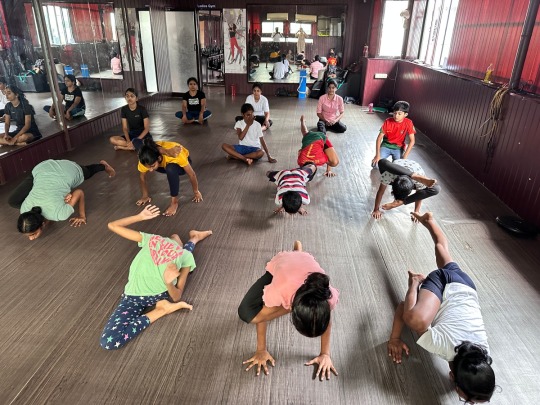
View On WordPress
#8 limbs of yoga#asana#Ashtanga Yoga#Dharma#dharna#dhyana#niyama#pranayama#pratyahara#samadhi#Yama#Yoga#Yoga discipline
0 notes
Text
Week 5 - Daka's Message: The Yogic Principles of Conduct
As we launch into the 5th week of our Homoerotic Tantra℠:Mascul-IN-Touch℠ 108 Days of Meditation & Reflection, I’d like to provide a bit of an introduction to the themes on which we’ll be meditating in the coming days. Homoerotic Tantra℠:Mascul-IN-Touch℠ is a yogic tāntric program for gay and bisexual men. As a “yogic” program, Homoerotic Tantra℠:Mascul-IN-Touch℠ practices the principles and…

View On WordPress
#Bisexual Men#Bodywork#Gay Men#Gay Tantra#Homoerotic#Masculinity#Massage#Meditation#Niyama#Tantra#Warrior#Warrior Path#Yama#Yoga
1 note
·
View note
Text
The Yamas and Niyamas are ethical and moral guidelines
The Yamas and Niyamas are ethical and moral guidelines outlined in the ancient yogic philosophy of Patanjali's Yoga Sutras. They offer principles for living a harmonious and fulfilling life. Here are the benefits associated with practicing the Yamas and Niyamas:
Yamas:
Ahimsa (Non-violence): Practicing ahimsa promotes peace and compassion. It encourages individuals to cultivate kindness towards themselves and others, leading to improved relationships and a more harmonious society.
Satya (Truthfulness): Living truthfully fosters authenticity and integrity. Being honest with oneself and others builds trust and strengthens connections, resulting in healthier relationships and a sense of inner peace.
Asteya (Non-stealing): By practicing asteya, individuals learn contentment and gratitude for what they have. This cultivates a mindset of abundance rather than scarcity, promoting generosity and reducing feelings of envy or lack.
Brahmacharya (Moderation): Brahmacharya encourages balanced living and mindful consumption. By practicing moderation in all aspects of life, individuals conserve energy, maintain focus, and cultivate self-discipline, leading to greater physical, mental, and emotional well-being.
Aparigraha (Non-attachment): Aparigraha teaches the art of letting go and releasing attachments to outcomes. By detaching from material possessions, expectations, and desires, individuals experience freedom from stress, anxiety, and dissatisfaction, leading to greater contentment and inner peace.
Niyamas:
Saucha (Purity/Cleanliness): Practicing saucha involves purifying the body, mind, and environment. This fosters clarity of thought, enhances physical health, and creates a conducive space for spiritual growth and self-discovery.
Santosha (Contentment): Santosha promotes gratitude and acceptance of the present moment. Cultivating contentment regardless of external circumstances leads to greater peace of mind, reduced stress, and an increased sense of fulfillment.
Tapas (Discipline): Tapas involves cultivating self-discipline and perseverance in pursuit of spiritual growth and personal development. By embracing challenges and overcoming obstacles, individuals build resilience, inner strength, and a sense of accomplishment.
Svadhyaya (Self-study): Svadhyaya encourages self-reflection and introspection. By studying sacred texts, exploring personal beliefs, and observing one's thoughts and actions, individuals gain insight into themselves, deepen their understanding of life's mysteries, and foster spiritual evolution.
Ishvara Pranidhana (Surrender to the Divine): Ishvara Pranidhana involves surrendering to a higher power or divine intelligence. By relinquishing the ego's need for control and trusting in a greater purpose, individuals find peace, guidance, and spiritual connection.
Overall, practicing the Yamas and Niyamas promotes personal growth, ethical behavior, and spiritual development. By aligning one's actions with these principles, individuals cultivate virtues such as compassion, truthfulness, contentment, and self-discipline, leading to a more fulfilling and meaningful life.
#astrology numerology vedicastrology#vedic astrology#vedas#vedic jyotish online#astrology#vedic astro observations#lordkrishna#krishna#harekrishna#hare krishna#vedic culture#veda#vedanta
28 notes
·
View notes
Text
Importance of yoga in our life

Yoga is an Indian spiritual and physical practice or discipline that dates back to prehistoric times. Contrary to what some people may think, yoga is not just about exercise with the primary goal of improving health and well-being, but it is also about self-actualization.
The importance of yoga in our lives cannot be underestimated. It is a science that focuses on improving not only physical health but also mental and spiritual well-being, which are the basis of our life.
You will be surprised to know how many health benefits yoga provides. From relieving stress and weight management to improving your overall health, this ancient practice can help you live a perfect life.
A brief look at yoga:- Yoga is an ancient art that has helped millions of people around the world achieve better physical and mental health.
Nowadays everyone uses it, especially those who suffer from stress and back pain. Yoga is generally considered to be related to physical exercise, but yoga is not just exercise. Yoga also strengthens and heals a person's mind and leads him to live a better life. The best yoga websites will guide you through the right poses for your body, helping you improve your health in ways you never imagined before.
The yoga trend is increasing all over the world. One of the main reasons for its popularity is that even doctors recommend yoga to their patients. Yoga is being widely studied by scientists and has been shown to calm and relax both the mind and body and uplift the spirit. This is an extraordinary discipline to have a good mind and stay healthy.
Importance of yoga mental benefits:- Apart from the physical benefits, one of the best benefits of yoga is how it helps a person manage mental health. Most importantly, yoga helps deal with stress, which has devastating effects on the body and mind. According to Dr. Nevins, "Stress can manifest itself in a variety of ways, including back or neck pain, sleep problems, headaches, drug abuse, and inability to concentrate." Yoga can be very effective in developing coping skills. This practice helps people achieve a more positive outlook on their lives.
Iincreased concentration:- Better concentration is one of the many benefits of a calm mind. People who have survived modern life know the importance of concentration as they are often busy with multiple tasks. Meditation is a powerful practice for sharpening concentration. In meditation, whenever your mind wanders, you direct your attention to your breath, a mantra, or an image.
Strength and flexibility:- A sedentary lifestyle causes many physical health problems, such as limited flexibility, low strength, poor posture, stiffness, and much more. Performing yoga asanas encourages movement of the body in different directions, helps to open up which reduces stiffness, increases joint mobility and releases repressed emotions which leads to strength and flexibility.
Increased strength and flexibility are important for healthy maintenance of muscles, tissues and ligaments.
Discipline and caution in life. By applying the Yamas and Niyamas written in the Yoga Sutras of Patanjali, you invite greater discipline and mindfulness into your life. The five Yamas and Niyamas are moral rules for living a virtuous life.
Respecting this ethic throughout life means being conscious in every action, acting with compassion and living in the present moment.
Final word:- Yoga is rightly called "the science of living in harmony with oneself and the world": it not only helps keep our body in shape but also helps keep our mind and soul active. This practice combines body, mind and spirit and allows us to be happy, peaceful and content by changing our attitude, behavior and approach towards life. It makes us more positive, optimistic and happy.
Yoga is very important to people and can also have a positive impact on the world. At PIES, we are focused on making sure you have the best yoga experience in Northern Virginia. Our studio in Alexandria, Virginia has a variety of yoga programs and classes for beginners and seniors. Call us at 703-940-1948 to schedule your class.
#yoga#yoga pose#yoga inspiration#yoga daily#girls in yoga pants#fitness#wellness#pilates#exercise#health and fitness#health care#healthylifestyle#mental health#healthcare#health & fitness#doctors#health and wellness#public health#medicine
7 notes
·
View notes
Text
The Breath of Life: A Book Review of Light on Pranayama: The Definitive Guide to the Art of Breathing
Original Article Published on My Book Recommendation website: https://majumdarbookreviews.asia and then published at https://majumdarbookreviews.blog
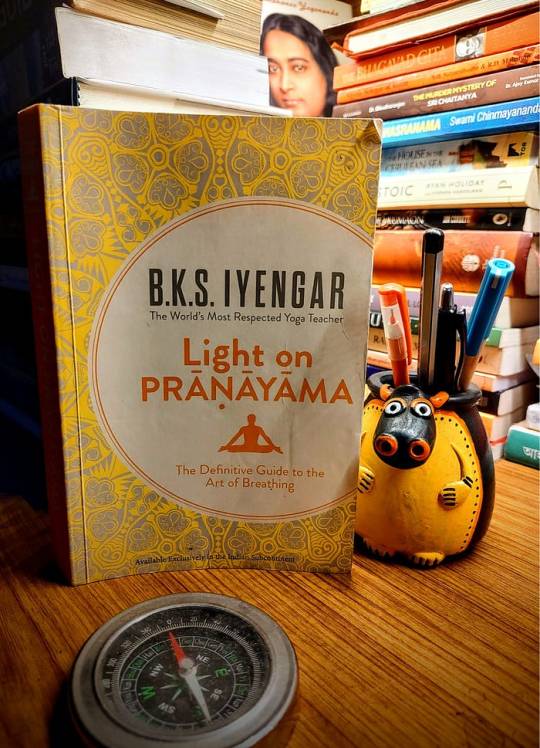
Photograph of the Book, ‘Light on Pranayama’, written by B.K.S. Iyengar
In the ancient cultures of our world, the art of maintaining physical health has always been revered. The philosophy of India profound in its understanding of life, declares that while the body may return to dust, life is sustained by the forces of air, transformed through the element of fire into energy, light and radiance.
This transformation of matter into finer forms is the very source of our strength. Yet, true strength lies not merely in the transmutation of matter but in the complete cycle where air and light are taken in, transformed and returned to the universe.
Yoga, as taught by the seers of India transcends mere physical postures. It is a scientific and systematic discipline for the harmonious alignment of all the energies within the human being leading one towards communion with the Divine. In its various forms – Hatha Yoga, Raja Yoga, Jnana Yoga, Kundalini Yoga, Mantra Yoga, Laya Yoga – yoga remains a pathway to the ultimate reality.
Among these, Pranayama, the control and mastery of the life force is central to the yogic discipline.
In this remarkable book, the author brings to light the profound significance of Pranayama. Sri Aurobindo, the great sage of Pondicherry shared from his own experience how Pranayama amplified his mental faculties, enabling him to compose and retain vast amounts of poetry – an astonishing feat of mental clarity and focus. Such is the power that resides within the breath or prana.
Prana, in the yogic tradition is far more than mere air or breath. It is the essence of life itself, pervading both the animate and inanimate. It flows through us as the vital currents – prana, apana, vyana, udana and samana – governing the energies of our body and mind. Pranayama is thus a sacred practice not just a technique but a way of aligning ourselves with the cosmic life force.
The ancient texts starting with Patanjali treat Pranayama as an indispensable part of the spiritual journey. In today’s fast-paced world where life is fraught with stress, anxiety and illness, many have turned to fleeting and harmful distractions like smoking and intoxicants in search of relief. Yet, as this book reveals, Pranayama holds the key to lasting peace and health. It begins by easing minor ailments such as colds, headaches and mental unrest and gradually leads the practitioner to a state of balance and harmony. However, it is not something to be grasped through mere intellectual discourse. It must be practiced with patience, care and devotion.
The author wonderfully expounds upon the true meaning of yoga. Derived from the Sanskrit root “yuj,” yoga means to bind, to join, to unite. It is the union of the soul with the divine, the alignment of the scattered forces of the mind into a state of reflection and clarity. The eight limbs of yoga – Yama, Niyama, Asana, Pranayama, Pratyahara, Dharana, Dhyana and Samadhi – are the steps on this sacred journey and each is explained in great detail within this work.
The section on breath, its nature and how few truly understand the art of breathing is especially illuminating. Some times I feel like asking myself a simple yet profound question: “Do I know how to breathe?”
The author further points out that poor posture, emotional imbalances and neglect of our respiratory muscles all contribute to improper breathing, which in turn diminishes our vitality.
The author also delves into the intricate systems of nadis and chakras, which govern the flow of prana within the body. Of the 350,000 nadis mentioned in the Siva Samhita, fourteen are considered significant, with the three most vital being Sushumna, Ida and Pingala.
B.K.S. Iyengar, the author of this work, is widely regarded as one of the foremost teachers of yoga in the world, bringing this ancient knowledge to the West. His teachings have been transformative for countless practitioners and his insights into Pranayama are invaluable.
The book ‘Light on Pranayama’ is a treasure trove of wisdom, offering profound insights into the ancient art of breathing and life force control. It has deepened my understanding of Pranayama and how to practice it correctly. I would give it a rating of nine out of ten for its clarity, depth and the invaluable lessons it imparts.
These reflections are but my own humble interpretation and I welcome inputs and suggestions from readers. I thank you for your time and consideration of these thoughts and I deeply respect any differing perspectives that may arise.
You may also visit my Book Review and Book Recommendation website: https://majumdarbookreviews.asia
Thanks and regards,
Mainak Majumdar, Book Critic
Email: [email protected] & [email protected]
#books & libraries#books and coffee#books and literature#books and reading#bookshelf#books#booksbooksbooks#bookstagram#bookstore#children's books#writers on tumblr#writers and poets#writerscommunity#creative writing#writing community#writer stuff
2 notes
·
View notes
Note
I have been thinking of getting into yoga lately. Are yoga poses able to quiet the mind? Especially the ones of youtube? I'm a bit skeptical about it because i don't see people talking about using it to realize self.
Of course it can! From a western point of view, yoga is often only known as a physical exercise but actually, yoga is so much more than that and there are many forms of yoga. My favourite is yoga nidra because you just lie in corpse pose and do nothing (besides following audio instruction to move awareness across various body parts), it's basically meditation. If you're interested in this, then I advise you to be wary of a lot of the youtube recordings because a lot of them are not authentic yoga nidra, you're not actually supposed to fall asleep from doing it but I kept falling asleep because the teacher wasn't actually giving yoga nidra instructions lol.
Yoga is a group of physical, mental, and spiritual practices or disciplines which originated in ancient India and aim to control and still the mind, recognizing a detached witness-consciousness untouched by the mind and mundane suffering. - Wikipedia
Yoga postures (asanas) is the third limb of the eight limbs of yoga from the ancient Yoga Sutra texts. It can also be used as a way to freedom/self-realization.
Yoga is the stilling of the fluctuations of the mind. The Yoga Sutras of Patanjali (fourth century CE) give us tools to still those fluctuations, with Ashtanga Yoga, the eight limbs of Yoga: Yama (restraints), Niyama (observances), Asana (posture), Pranayama (control of breath), Dharana (concentration), Pratyahara (sense withdrawal), Dhyana (meditation) and Samadhi (undeviated absorption). Source (I suggest you read this)
Also just try whatever you feel led to and then you'll see whether it works for you or not. You got the idea of yoga for a reason. You don't need anyone's confirmation nor need other people to have done it or succeeded in it for it to work for you. You don't need to do what's already been done before either in order to personally succeed in what you want. Be your own scientist!
11 notes
·
View notes
Text
Los Orígenes del Yoga: Un Viaje Espiritual a Través del Tiempo
Por Yoga Muladhara, Gimnasio de Yoga
El yoga es una práctica milenaria que ha ganado popularidad en todo el mundo por sus beneficios físicos, mentales y espirituales. Aunque muchos conocen el yoga como una serie de posturas y ejercicios de respiración, sus orígenes son profundamente espirituales y filosóficos, enraizados en la antigua tradición india. En este artículo, exploraremos los orígenes del yoga, su evolución a lo largo del tiempo y su impacto duradero en la cultura y la espiritualidad global.
Los Primeros Vestigios del Yoga
Orígenes Prehistóricos
El yoga se remonta a la prehistoria, con evidencias de su práctica encontradas en la civilización del Valle del Indo, alrededor del 3000 a.C. Se han descubierto sellos y figuras que representan posturas de meditación y yoga en sitios arqueológicos como Mohenjo-Daro y Harappa.
La Era Védica
La primera referencia textual al yoga se encuentra en los Vedas, los textos sagrados más antiguos de la India, que datan de alrededor del 1500 a.C. En los Vedas, el yoga se menciona en el contexto de la meditación y el ritual, como un medio para alcanzar la unión con lo divino. Sin embargo, es en los Upanishads, una serie de textos filosóficos que surgieron más tarde, donde el yoga comienza a adquirir una forma más estructurada y filosófica. Los Upanishads exploran conceptos fundamentales del yoga, como la naturaleza del ser (atman), la realidad última (brahman) y la conexión entre ambos.
El Surgimiento del Yoga Clásico
Los Yoga Sutras de Patanjali
El desarrollo más significativo en la historia del yoga se produjo con los “Yoga Sutras” de Patanjali, escritos alrededor del siglo II a.C. Patanjali sistematizó el conocimiento yóguico existente en 196 sutras o aforismos, creando una guía comprensiva para la práctica del yoga. Los “Yoga Sutras” presentan el Ashtanga Yoga o el “Yoga de los Ocho Pasos”, que incluye:
Yamas (restricciones éticas)
Niyamas (observancias personales)
Asanas (posturas)
Pranayama (control de la respiración)
Pratyahara (retirada de los sentidos)
Dharana (concentración)
Dhyana (meditación)
Samadhi (absorción completa)
Bhagavad Gita
Otro texto crucial en la historia del yoga es el “Bhagavad Gita”, escrito entre el siglo V y II a.C. Este diálogo entre el príncipe Arjuna y el dios Krishna, presente en el épico “Mahabharata”, ofrece una visión del yoga como un camino de acción (Karma Yoga), devoción (Bhakti Yoga) y conocimiento (Jnana Yoga). La “Bhagavad Gita” destaca la importancia del desapego y la dedicación al deber como formas de alcanzar la liberación espiritual.
La Evolución del Yoga
Yoga en la Edad Media
Durante la Edad Media, el yoga continuó evolucionando con la aparición de nuevas escuelas y tradiciones. El Hatha Yoga, que se centra en la práctica de asanas y pranayama, comenzó a desarrollarse alrededor del siglo XI. Textos como el “Hatha Yoga Pradipika” y el “Gheranda Samhita” proporcionaron instrucciones detalladas sobre las posturas y técnicas de respiración, preparando el terreno para las formas modernas del yoga que conocemos hoy.
La Era Moderna
El yoga moderno comenzó a tomar forma en el siglo XIX y principios del XX, con figuras clave como Swami Vivekananda, quien introdujo el yoga en Occidente a través de sus discursos en el Parlamento Mundial de las Religiones en Chicago en 1893. Otros maestros, como Tirumalai Krishnamacharya, B.K.S. Iyengar y Pattabhi Jois, desarrollaron y popularizaron diversas formas de yoga que se han difundido globalmente.
Yoga en el Siglo XXI
Hoy en día, el yoga es una práctica global que abarca una variedad de estilos y enfoques, desde el Hatha Yoga tradicional hasta formas más modernas como el Vinyasa y el Bikram Yoga. A pesar de sus diversas manifestaciones, el yoga sigue siendo un camino hacia el bienestar integral, ofreciendo herramientas para la paz mental, la salud física y la conexión espiritual.
Los Orígenes del Yoga: Un Viaje Espiritual a Través del Tiempo
Por Yoga Muladhara, Gimnasio de Yoga
El yoga es una práctica milenaria que ha ganado popularidad en todo el mundo por sus beneficios físicos, mentales y espirituales. Aunque muchos conocen el yoga como una serie de posturas y ejercicios de respiración, sus orígenes son profundamente espirituales y filosóficos, enraizados en la antigua tradición india. En este artículo, exploraremos los orígenes del yoga, su evolución a lo largo del tiempo y su impacto duradero en la cultura y la espiritualidad global.
Los Primeros Vestigios del Yoga
Orígenes Prehistóricos
El yoga se remonta a la prehistoria, con evidencias de su práctica encontradas en la civilización del Valle del Indo, alrededor del 3000 a.C. Se han descubierto sellos y figuras que representan posturas de meditación y yoga en sitios arqueológicos como Mohenjo-Daro y Harappa, lo que sugiere que las prácticas yóguicas eran conocidas y posiblemente ampliamente practicadas en esa época.
La Era Védica
La primera referencia textual al yoga se encuentra en los Vedas, los textos sagrados más antiguos de la India, que datan de alrededor del 1500 a.C. En los Vedas, el yoga se menciona en el contexto de la meditación y el ritual, como un medio para alcanzar la unión con lo divino. Sin embargo, es en los Upanishads, una serie de textos filosóficos que surgieron más tarde, donde el yoga comienza a adquirir una forma más estructurada y filosófica. Los Upanishads exploran conceptos fundamentales del yoga, como la naturaleza del ser (atman), la realidad última (brahman) y la conexión entre ambos.
El Surgimiento del Yoga Clásico
Los Yoga Sutras de Patanjali
El desarrollo más significativo en la historia del yoga se produjo con los “Yoga Sutras” de Patanjali, escritos alrededor del siglo II a.C. Patanjali sistematizó el conocimiento yóguico existente en 196 sutras o aforismos, creando una guía comprensiva para la práctica del yoga. Los “Yoga Sutras” presentan el Ashtanga Yoga o el “Yoga de los Ocho Pasos”, que incluye:
Yamas (restricciones éticas)
Niyamas (observancias personales)
Asanas (posturas)
Pranayama (control de la respiración)
Pratyahara (retirada de los sentidos)
Dharana (concentración)
Dhyana (meditación)
Samadhi (absorción completa)
Bhagavad Gita
Otro texto crucial en la historia del yoga es el “Bhagavad Gita”, escrito entre el siglo V y II a.C. Este diálogo entre el príncipe Arjuna y el dios Krishna, presente en el épico “Mahabharata”, ofrece una visión del yoga como un camino de acción (Karma Yoga), devoción (Bhakti Yoga) y conocimiento (Jnana Yoga). La “Bhagavad Gita” destaca la importancia del desapego y la dedicación al deber como formas de alcanzar la liberación espiritual.
La Evolución del Yoga
Yoga en la Edad Media
Durante la Edad Media, el yoga continuó evolucionando con la aparición de nuevas escuelas y tradiciones. El Hatha Yoga, que se centra en la práctica de asanas y pranayama, comenzó a desarrollarse alrededor del siglo XI. Textos como el “Hatha Yoga Pradipika” y el “Gheranda Samhita” proporcionaron instrucciones detalladas sobre las posturas y técnicas de respiración, preparando el terreno para las formas modernas del yoga que conocemos hoy.
La Era Moderna
El yoga moderno comenzó a tomar forma en el siglo XIX y principios del XX, con figuras clave como Swami Vivekananda, quien introdujo el yoga en Occidente a través de sus discursos en el Parlamento Mundial de las Religiones en Chicago en 1893. Otros maestros, como Tirumalai Krishnamacharya, B.K.S. Iyengar y Pattabhi Jois, desarrollaron y popularizaron diversas formas de yoga que se han difundido globalmente.
Yoga en el Siglo XXI
Hoy en día, el yoga es una práctica global que abarca una variedad de estilos y enfoques, desde el Hatha Yoga tradicional hasta formas más modernas como el Vinyasa y el Bikram Yoga. A pesar de sus diversas manifestaciones, el yoga sigue siendo un camino hacia el bienestar integral, ofreciendo herramientas para la paz mental, la salud física y la conexión espiritual.
En Yoga Muladhara, honramos esta rica herencia y te invitamos a explorar el yoga en todas sus dimensiones, para encontrar no solo un cuerpo más fuerte y flexible, sino también una mente más tranquila y un espíritu más conectado. ¡Únete a nosotros en este viaje transformador!
4 notes
·
View notes
Text
How do Patanjali's ethics apply to a commodified yoga world?

Introduction
Our current societal model based on capitalism, consumerism, commodification of products, bargains and unethical practices is well embedded in our current way of living. It has developed and evolved over thousands of years from when salt was used as currency to the paper currency we use today, and we are heading into a future where virtual currencies will be used.
A multifaceted and complex dilemma is presented to yoga teachers, studio owners, attendees/students of yoga classes as to what the best way is to share/promote/attend/participate in yoga within our current societal model. On the one hand we are faced with a capitalistic model which drives us to sell products, make money and earn a living to support our lifestyles (in this case the modus operandi is yoga) and on the other hand yoga philosophy has a deep and centuries old moral compass. The most famous philosophical and ethical text is known as Patanjali's Yoga Sutras.
In this blog post we are going to explore some of the tensions that are presented to people embarking on a journey into the yoga world. (The term people here embraces yoga teachers, studio owners and attendees/students of yoga classes.)
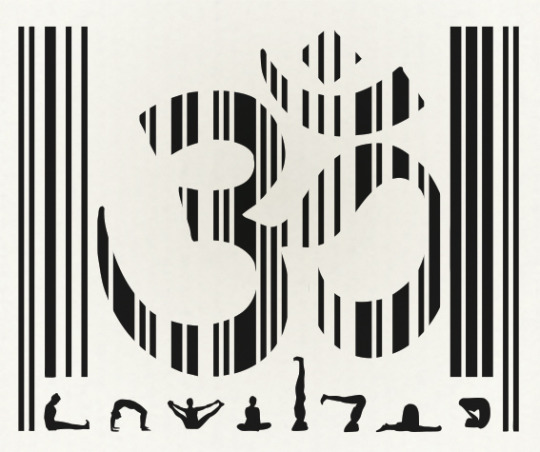
Image: Original source unknown
Yoga as a commodity
Let us begin by looking at how yoga has become a commodity within the capitalistic model. There has been an explosion of yoga across the globe. Between 2010 and 2021 yoga grew in popularity by at least 64%. In the last decade yoga has been incorporated and embedded into the health, wellbeing and fitness industries. Let us take a look at some key statistics...

More than 300 million people practice yoga globally and the global yoga market size was valued at USD 115.43 (£91.61) billion in 2023. The market is further projected to grow at a CAGR of 9% between 2024 and 2032, reaching a value of USD 250.70 (£198.97) billion by 2032. Source: www.expertmarketresearch.com/reports/yoga-market. Please note that the statistic taken from the site called Expert Market Research vary to the ones being shared in the above image. We are not sure how things are being measured/calculated in either source to account for the variation. Nevertheless, we get an idea of what is happening.
In the United Kingdom, as of 2023:
The Pilates and yoga industry has a revenue of over £895 million
There are over 18,000 yoga and Pilates employees in the UK.
There are over 4,800 yoga and Pilates businesses in the UK.
Up to 460,000 Brits are taking part in yoga classes each week.
Source: www.finder.com/uk/yoga-statistics
There is no doubt about it, yoga has now become a product to sell. Not just from attending classes/workshops/retreats but from all the by-products one can purchase, from clothing to yoga mats that go with it. The commodification of yoga has had huge ramifications on the tradition itself. In fact, if you put the word yoga on a product it seems you can sell it for twice as much. See the image below taken from the Talk Talk website, demonstrating how ubiquitous yoga has become in selling any product. Not sure how faster broadband and yoga are related?! Granted one of the benefits of yoga is peace of mind but the purpose of “true” yoga is not to sell broadband, to sell itself or any other product!

Yoga image selling broadband. Not sure how the two are related?!
How has yoga been commodified over the last decade?
In this section we are going to briefly explore what the yoga landscape looked like before and after its commodification.
How the masses perceive yoga
Before
Many people did not have an understanding of what yoga was and a lot of people would think that if you practiced yoga, you had joined some sort of cult, wore robes and chanted Om all day long. Some people still think this is the case today.
After
It could be argued that people still do not understand what yoga is today and perhaps have even less of an understanding than before it was commodified. Most people “think” they have an idea of what yoga “might” entail. The essence of yoga has been diluted and is slowly getting lost. Social media has played a significant role in promoting yoga as mainly for the fit, athletic and body beautiful. Lots of people think yoga is about contortions, difficult gymnastic style postures and standing on one’s head. Type in yoga on any search engine and we will see beautiful, perfect people in the most unattainable postures (that is, unattainable for most people).


Practitioners of Yoga
Before
Yoga was practiced by very few people and practitioners of yoga came to it for many different reasons; it was marginalised or an activity that lingered on the fringes of society. It was mainly considered to be a spiritual path to follow. The great majority of students would have sought out yoga as a deeper meaning to their life experience, however, there would have been some people, as today, who would first start yoga for the physical benefits and perhaps with time they would delve into the deeper aspects of it.
After
It is a very mixed bag. You will still find people practicing yoga for a deeper meaning but there has been a surge of people who in the past would not have ventured into a class, who are now finding their way to gyms/studios and are exploring yoga as a way to get fit and get the famous yoga bum. Many of these people may just stay in the realm of the physical yoga world but some may dive deeper.
Yoga Classes/Styles of Yoga
Before
The main styles of yoga used to be Hatha, Ashtanga and Iyengar. Most classes were for 90 minutes and were predominantly held in church halls or community centres. The classes would include not just postural work but would also explore breathing, meditation, energy/chakra work, relaxation, nidra and in some classes the history and philosophy of yoga would also be explored.
After
There is a boom in yoga styles from rocket yoga to dog and beer yoga and everything in between. Yoga starts to mix with other fitness modalities so that aerial, acro, Pilates (yogalates), yoga with weights and hot yoga begin to emerge. Class durations can be anywhere between 10 to 90 mins. Gyms, fitness organisations, health and well-being centres start to have a great variety of yoga classes on their timetable. There is an explosion of yoga on social media platforms and YouTube.
There is also a boom in yoga studios as they start to emerge everywhere. The majority of studios are managed by highly trained and experienced practitioners of yoga, but some studios are also being opened and managed by people who do not even have a yoga teaching qualification. Some studios offer yoga in a fairly traditional and authentic format while others offer yoga to Ibiza tunes and other types of playlists. Some of the less traditional yoga studios begin branching out to include other health and wellbeing experiences such as ice baths, saunas, the Wim Hoff method, Reiki yoga, yoga with massage and so forth.
Teacher Trainings
Before
Teacher trainings were few and far between and were of a very high standard. Most of them requiring a commitment of study of a minimum of three years and the participants on the training had a minimum requirement to have been practicing yoga for at least three years. Teacher trainings were only offered by a select and very well-respected yoga schools/ashrams.
Teacher trainings involved rigorous assessment and course work. If standards were not met many people would not receive their yoga qualification.
After
A plethora of teacher trainings begin to appear on the market from courses that can be completed in a couple of weeks, a month or a period of a year, and there are online courses, in-person courses or hybrids. The syllabuses of these trainings are based on the number or contact hours, for example 200, 500 hours etc.
Organisations such as Yoga Alliance and Independent Yoga Network begin to appear on the market from about 1999. Their role is to uphold some sort of standard but as the whole industry is following the consumer narrative, a lot of teacher trainings are passed by these organisations so that everyone can make some money from selling yoga. Organisations that used to accredit trainings for the fitness industry only, such as REPs and Active IQ also jump on the yoga gravy train, and they too begin to accredit yoga teacher trainings.
Yoga Teachers
Before
The majority of yoga teachers were highly trained and experienced. There were very few yoga teachers in any given local area and most of the teachers in an area had heard of each other and perhaps even knew each other. Teachers were respectful of where they set up their classes, having discussions with other teachers in the area and checking in if it was ok to teach in a similar area or space.
Yoga teachers would not undercut each other, and most classes were priced very similar to each other. Yoga teachers could earn a reasonable income that supported their lifestyles.
A lot of teachers believed that yoga was a radical path in creating a different world. One in harmony with the ebbs and flows of the natural world. Respecting all beings and protecting all of our collective resources. Many try to follow Patanjali’s Yoga Sutras to the best of their ability.
After
The quality and experience of teachers is a mixed bag. Many have completed a one-month intensive teacher training that is accredited, for example, as a 200 Yoga Alliance teacher training. As the teacher trainings are short and intense many teachers may and can lack the depth of understanding of the energetics that lie behind a practice. Furthermore, the long, rich and diverse history and philosophy of yoga cannot be covered on these short intensive trainings. Only a few keystone yoga texts (if that) can be explored on these trainings. As such a very biased view is being shared, including a lot of misinformation.
There is a boom of yoga teachers on the scene and as such teachers start to undercut each other and are not as sensitive to each other in relation to how they advertise their classes or the spaces or areas they use to teach in.
On the whole yoga teachers are not paid well, and it is very difficult to make a modest living. Studios in particular do not pay their teachers well. The remuneration of a teacher working in a studio is dependent upon the number of people attending. The more people attending the better the remuneration. There is a lot of burn out in the industry.
Class prices
Before
Teachers valued their own and other teachers’ time and commitment to getting trained and experienced in yoga. Teachers would spend many years and thousands of pounds obtaining their yoga qualification(s). As such no one undercut each other, and everyone offered yoga at a similar and fair price.
Teachers would use a variety and similar payment options to other teachers in an area. The intention behind these payment options is quite different to what we see today. Many teachers believe in a world where the societal model is not driven by greed, profit and consumerism but is based on fairness, openness, and harmony. As such when teachers offered payment options such as: a donation box where students could pay what they could afford; offering classes for free; an energy exchange of services; a reasonable fee for the class, it was not done with the intent to ruthlessly grow a business or undercut any other yoga teacher sharing yoga in the area.

Cartoon (and the one above) from: 'Rethinking consumerism for the sake of young people’s mental health (and the planet)' on issuesonline.co.uk
After
It is now a highly competitive market and as such to fill studios/classes teachers and studio owners have bought into the capitalistic and consumer narrative. To draw people in a lot of places offer free, discounted classes or even give their regular members money each time they refer a friend. Many studios/teachers may also offer unlimited yoga at a very cheap price. Furthermore, we start to see studios/teachers offering sales on Black Friday and Cyber Monday and so on! It is clearly not a one-way street as the consumers i.e. students/participants of yoga classes are supporting this model by purchasing the slashed/discounted yoga classes. Thereby the capitalistic, consumer narrative continues to become deeply ingrained through the commodification of our yoga practice.

Image from 'The New Spiritual Consumerism' on The New York Times
Yoga Products
Before
It was really hard to find yoga mats and it was quite impossible to find all the other yoga accessories that one can find on the market today.
After
The word yoga is used to sell everything from laptops to yoga mats and many other yoga products and also products which have nothing to do with yoga.

Cartoon by polyp.org.uk
Festivals/Expos
Before
There were very few yoga festivals and no yoga conventions/expos.
After
A plethora of yoga festivals have emerged. There is an international yoga day now. In the UK there are two big yoga conventions/expos every year, called the Om Yoga Show.
What is the eight-fold path from Patanjali’s Yoga Sutras?
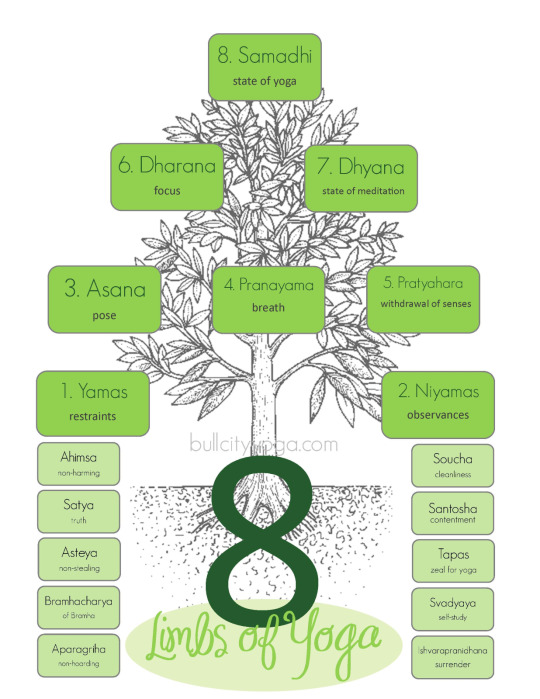
Image: Original source unknown
The Yoga Sutras is generally considered a foundational text of the yoga tradition. Most scholars these days date the Yoga Sutras to somewhere between the 2nd and 5th centuries CE, with Philipp Maas placing it in the early 5th century. Yoga had already been around in some form or another for many centuries by this point. Therefore, Patanjali did not ‘invent’ Yoga. Nevertheless, this is the earliest comprehensive and systematic text on the subject that has survived.
From this text we will be focusing on the second chapter. As it is in this chapter where the eight-fold (ashtanga, where ash means eight and tanga means limbs or auxiliaries) path is discussed. Here we find the famous exposition of five ethical restraints (yamas) and five ethical observances (niyamas) and these are relatively well-known in the modern yoga world. For this blog we are particularly interested in the following four yamas:
Ahimsa (non-harming)
Satya (truth telling)
Asteya (non-stealing)
Aparigraha (non-acquisitiveness)
For a full blog post on the Yoga Sutras click here.
As a yoga community is it possible to have a narrative which is in line with Patanjali’s Yamas?
It is hoped that through this blog we have begun to gently shine the light on how our yoga practice has slowly become commodified over the last decade. The outcome of the commodification of yoga is that it can be packaged in many different ways and offered to consumers as overly and unreasonably priced classes and products to only then be reduced or slashed, offered for free or included in sales such as black Fridays, cyber-Mondays etc. to consumers.
Clearly trying to operate a yoga business within our current societal model is challenging. Particularly if the intention behind why we became a yoga teacher or studio owner is because we believe that yoga is a radical way to change our capitalistic consumer model and we do not wish to be driven by or support the current narrative. The fact is this current societal model is here for the time being and until the narrative changes, we need to operate within it. How do we do this without causing harm to ourselves, to other businesses and the wider community? We need to find a compromise and find some middle ground.
Somehow as yoga teachers, studio owners and attendees of yoga classes we need to find a harmonious middle path that enables us to find some balance by living within the current model and running and supporting yoga businesses in line with the values outlined in Patanjali’s Yoga Sutras.
If we wish to reconcile this, then it is very simple as a yoga community we should not be harming (practicing ahimsa); stealing (practicing asteya) and being greedy (practicing aparigraha). We should be truthful (satya) to ourselves, to our business, to our students, to studio owners/teachers and to our wider global community by providing services at honest prices, that value each other, our training, our knowledge and expertise.
We should jump off the capitalistic model by not buying into it, by setting prices that are appropriate thereby not undercutting or undervaluing the yoga community. In the long term hopefully shining our businesses as beacons of light which perhaps one day can navigate us away from the consumerism model that has enslaved us into meaningless lifestyles where we perpetuate and reinforce unhealthy relationships with ourselves and the wider global community.

Cartoon by www.speedbump.com
Conclusion
To swim against the capitalistic tide can be rewarding, challenging and at times isolating but looking at the bigger picture and setting examples by running businesses in a different way is very important particularly in our current global, societal/economic model.
Our businesses should be deeply rooted like trees in a healthy eco-system, with Patanjali’s yamas and niyamas as the roots/foundations of our businesses that go far and wide into the rich healthy soil. The invisible mycelium network connecting the woods via the root system expressing itself through the healthy conversation and conversion of the yamas and niyamas by sharing the knowledge with all the trees and inhabitants of that woodland so that the whole woodland/eco-system benefits, thrives and is healthy.
A complex system is a system composed of many components which may interact with each other in nonlinear and unpredictable ways. In time the small and seemingly trivial steps we make as yoga teachers and students may ultimately result in something with much larger consequences, a butterfly effect may be created in which small changes will result in significant nonlinear impacts to the complex system which is the capitalist consumer model.
Yoga used to be a path less followed and more challenging for a reason. To awaken one’s consciousness and internal light takes time, courage, commitment, effort and sacrifice. To run our businesses in a yogic way is part of embodying yoga values and it should be a core part of our yoga practice. To bring around real long-lasting change as a yoga community we need to set the example at the mycelium level for others to be inspired and follow. A healthy yamas/niyamas mycelium network reflects a healthy, vibrant and energetic yogic woodland community and planet Earth.

Art by Vchitras on Etsy
#thecommodificationofyoga#yogaconsumerism#yogawithinthecapatalisticmodel#yogaethics#yogamoralcompass#patanjalisyogasutras#yamas#niyamas#ahimsa#yogaclickbait#freeyoga#freeyogaclasses#referafriendforfreeyoga#blackfridaydeals#cybermondaydeals#myceliumnetwork#yoganaturesheffield
0 notes
Text

TBR from the queer yoga retreat i recently attended 🌈
🧚 The Path of Yoga
🧚 Lunar Living
🧚 100 Queer Poems
🧚 The Yamas and Niyamas
3 notes
·
View notes
Text
Uniting Body, Mind, and Soul: A Deep Dive into International Day of Yoga
As a Yoga practitioner, teacher, and scholar, I can confidently say that this millenary holistic practice is way more than just its asanas, the physical postures. International Day of Yoga It’s a transformative journey that brings together and nurtures our physical bodies, mental faculties, and intimate souls to dig deep into our truest selves. Every year, on June 21st, the world unites to…

View On WordPress
#Asana#Ashtanga#Body#Body Mind Soul#breathwork#Holistic#International Day of Yoga#Kaivalya#Mind#Narendra Modi#Niyamas#Patañjali#Pranayama#Purusha#Raffaello Palandri#Samadhi#soul#Yamas#Yoga#Yoga Sutras of Patañjali
1 note
·
View note
Text
Beginner yoga poses for flexibility and strength Embracing Ethical Principles and Inner Peace
Beginner Yoga, Poses For Flexibility And Strength a practice rooted in historical traditions, has advanced into a globally recognized discipline that encompasses physical, mental, and religious dimensions. Its origins trace lower back to historical India, in which it become developed as a comprehensive system for achieving balance, self-recognition, and holistic well-being. Today, yoga is practiced global, transcending cultural and geographical limitations. It offers a path to personal boom, fitness, and internal peace, integrating bodily postures, breath control, meditation, and ethical principles.

The Origins and Evolution of Yoga
The records of Yoga For Seniors dates returned lots of years, with its earliest mentions observed within the Vedic texts of historic India. The term “yoga” is derived from the Sanskrit word “yuj,” that means “to yoke” or “to unite,” signifying the union of the character self with the general attention. The historical practice become first of all a religious and philosophical pursuit geared toward accomplishing enlightenment and liberation from the cycle of delivery and rebirth.
Over the centuries, yoga for teens evolved thru numerous colleges of notion, which includes the classical Yoga of Patanjali, which is distinctive in the "Yoga Sutras." Patanjali’s machine emphasised the 8 limbs of yoga, which encompass moral hints (Yamas and Niyamas), physical postures (Asanas), breath manage (Pranayama), sensory withdrawal (Pratyahara), attention (Dharana), meditation (Dhyana), and ultimate absorption (Samadhi). This complete framework aimed to manual practitioners towards religious awakening and self-cognizance.
The Physical Practice: Asanas
One of the maximum recognizable elements of yoga in modern practice is Asanas, or bodily postures. These poses are designed to decorate physical flexibility, electricity, and stability while promoting standard fitness and well-being. The exercise of Asanas additionally facilitates to boom body recognition, coordination, and alignment.
The sort of yoga postures levels from simple stretches to complicated poses that require substantial energy and versatility. Common poses encompass the downward-facing dog (Adho Mukha Svanasana), warrior poses (Virabhadrasana), and tree pose (Vrksasana). Each posture has precise benefits and may be modified to deal with distinct ability stages and physical situations.
Beyond their bodily blessings, Asanas also are used to prepare the body and thoughts for deeper practices which include meditation. The subject of retaining those postures enhances mental attention and fosters a sense of inner calm.
Breath Control: Pranayama
Breath manipulate, or Pranayama, is any other necessary component of yoga. The time period "Pranayama" combines “Prana,” which means life pressure or breath, and “Yama,” meaning control. Pranayama includes diverse strategies for regulating and harnessing the breath to decorate power drift, enhance mental readability, and guide bodily fitness.
Techniques along with Ujjayi (victorious breath), Kapalabhati (skull-shining breath), and Nadi Shodhana (exchange nose respiration) each serve wonderful functions. Ujjayi breath, characterized with the aid of a mild constriction in the back of the throat, enables to calm the thoughts and preserve attention in the course of practice. Kapalabhati includes rapid, forceful exhalations accompanied by passive inhalations, which invigorates the thoughts and cleanses the breathing machine. Nadi Shodhana balances the left and proper hemispheres of the mind, promoting emotional stability and mental equilibrium.
Meditation and Mindfulness
Meditation, or Dhyana, is a valuable aspect of yoga that entails cultivating intellectual stillness and attention. The exercise of meditation facilitates to quiet the thoughts, lessen stress, and foster a deeper connection with one’s inner self. Through centered attention and mindfulness, practitioners learn how to observe their thoughts and feelings without attachment or judgment.
Various meditation strategies are employed in yoga, which include awareness on a mantra, visualization, or guided imagery. The intention of meditation is to reap a country of internal peace and clarity, transcending the distractions and conflicts of daily existence. Regular meditation exercise can result in improved emotional resilience, extended self-cognizance, and a greater sense of purpose and achievement.
The Ethical Dimensions: Yamas and Niyamas
Yoga isn't always entirely approximately physical postures and breath manage; it also encompasses moral hints that form a practitioner’s conduct and interactions with others. These hints are referred to as the Yamas and Niyamas, forming the first two limbs of Patanjali’s eightfold course.
The Yamas are ethical standards that deal with one’s relationship with the outside international. They include:
Ahimsa (Non-violence): Advocating kindness and compassion toward oneself and others.
Satya (Truthfulness): Encouraging honesty and integrity in thought, speech, and action.
Asteya (Non-stealing): Promoting respect for others’ possessions and thoughts.
Brahmacharya (Moderation): Encouraging stability and strength of mind, specially in relation to dreams and strength.
Aparigraha (Non-possessiveness): Fostering non-attachment and contentment with what one has.
The Niyamas are non-public observances that manual one’s internal behavior. They include:
Saucha (Purity):
Emphasizing cleanliness of frame and thoughts.
Santosha (Contentment):
Cultivating gratitude and attractiveness.
Tapas (Discipline):
Encouraging strength of will and perseverance.
Svadhyaya (Self-examine)
Promoting self-mirrored image and gaining knowledge of.
Ishvara Pranidhana (Surrender to a better energy)
Encouraging devotion and trust in a extra force or time-honored precept.
The Holistic Approach to Well-being
Yoga’s routines for improving posture and alignment holistic method encompasses now not simplest the bodily and mental elements however also the spiritual dimension. It fosters a experience of unity and harmony inside oneself and with the broader world. The practice of yoga encourages people to discover their internal selves, cultivate mindfulness, and increase a deeper connection with their environment.

Incorporating yoga into each day existence can result in advanced physical fitness, reduced strain, and a extra sense of inner peace. It gives gear for coping with life’s demanding situations, fostering resilience, and improving ordinary great of existence. Whether practiced in a studio, at domestic, or in nature, yoga gives a sanctuary for self-discovery and private boom.
#Yoga’s routines for improving posture and alignment#Yoga For Seniors#yoga for teens#Poses For Flexibility And Strength
2 notes
·
View notes
Text
What’s Yama and Niyama? The dos and don’ts of #Yoga.
🚫Kindness - Non-violence
🙏🏼 Truthfulness
🙅🏻♀️Non-stealing
⛔️Moderation - Non-excess
🫂Generosity- Non - possessiveness, Purity, Contentment, Austerity, Self-study and Surrender.✨
©️Credit ig @chandy
#yogainversion #headstand #lightonyoga #iyengaryoga #hatha #yogisofinstagram #yogilifestyle #yogi #lifestyle
14 notes
·
View notes